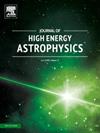Detection of polarized Fermi-bubble synchrotron and dust emission
IF 10.5
4区 物理与天体物理
Q1 ASTRONOMY & ASTROPHYSICS
引用次数: 0
Abstract
The elusive polarized microwave signal from the Fermi bubbles is disentangled from the more extended polarized lobes, which similarly emanate from the Galactic plane but stretch farther west of the bubbles. The projected synchrotron polarization reveals magnetic fields preferentially parallel to the bubble edges, as expected downstream of a strong shock. The projected polarization of thermal dust emission is similarly oriented, constraining grain alignment in an extreme environment. We argue that the larger lobes arise from an older Galactic-center, likely supermassive black-hole, outburst.
偏振费米泡同步加速器的探测与尘埃发射
来自费米气泡的难以捉摸的极化微波信号与更广泛的极化叶分离开来,后者同样来自银道面,但向气泡以西延伸得更远。预计的~ 20%同步加速器极化显示磁场优先平行于气泡边缘,如预期的强激波下游。预估的热尘埃发射的~ 20%极化也是类似的定向,在极端环境中限制了颗粒的排列。我们认为,较大的裂片是由一个更古老的星系中心产生的,可能是超大质量黑洞的爆发。
本文章由计算机程序翻译,如有差异,请以英文原文为准。
求助全文
约1分钟内获得全文
求助全文
来源期刊

Journal of High Energy Astrophysics
Earth and Planetary Sciences-Space and Planetary Science
CiteScore
9.70
自引率
5.30%
发文量
38
审稿时长
65 days
期刊介绍:
The journal welcomes manuscripts on theoretical models, simulations, and observations of highly energetic astrophysical objects both in our Galaxy and beyond. Among those, black holes at all scales, neutron stars, pulsars and their nebula, binaries, novae and supernovae, their remnants, active galaxies, and clusters are just a few examples. The journal will consider research across the whole electromagnetic spectrum, as well as research using various messengers, such as gravitational waves or neutrinos. Effects of high-energy phenomena on cosmology and star-formation, results from dedicated surveys expanding the knowledge of extreme environments, and astrophysical implications of dark matter are also welcomed topics.
 求助内容:
求助内容: 应助结果提醒方式:
应助结果提醒方式:


